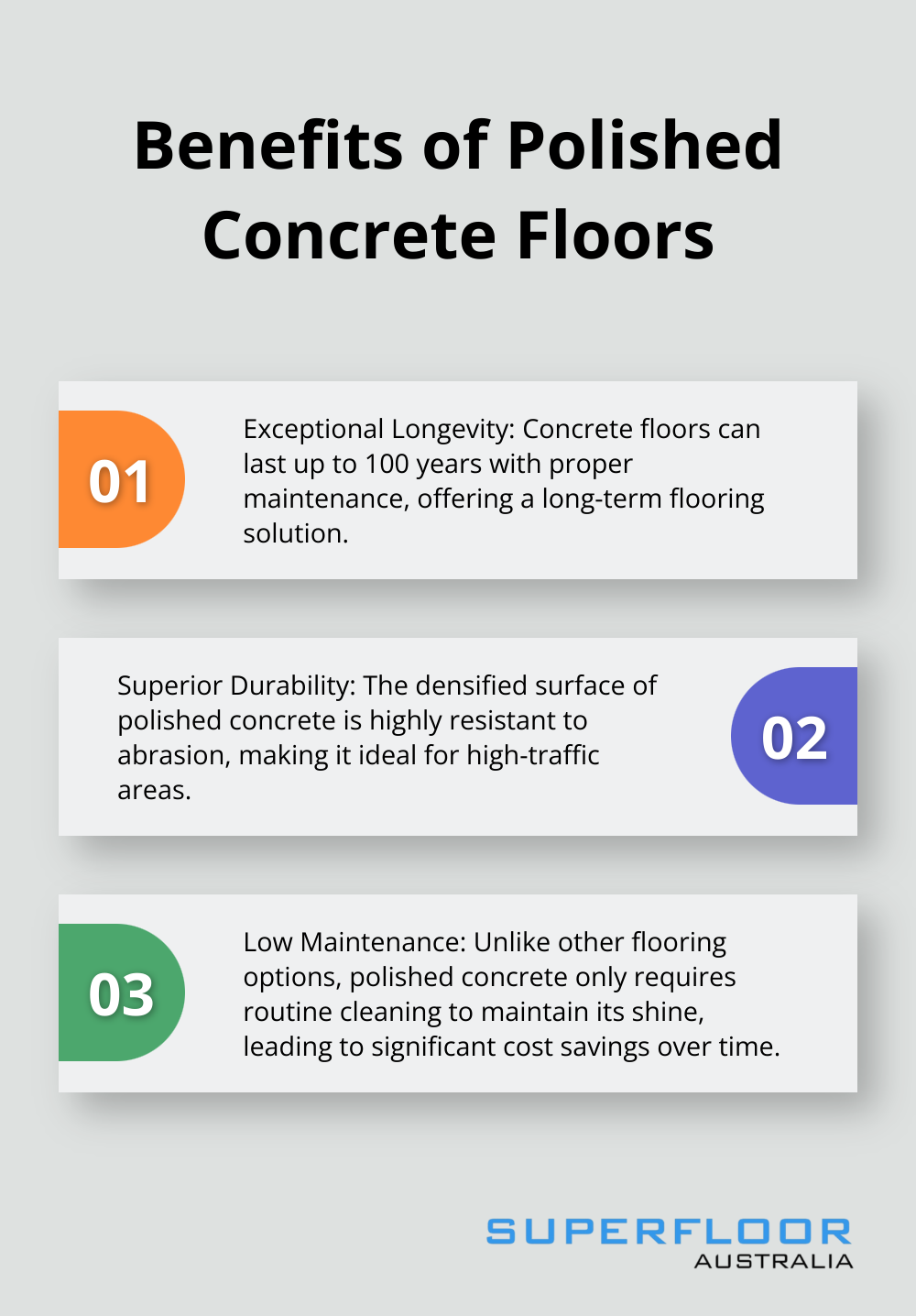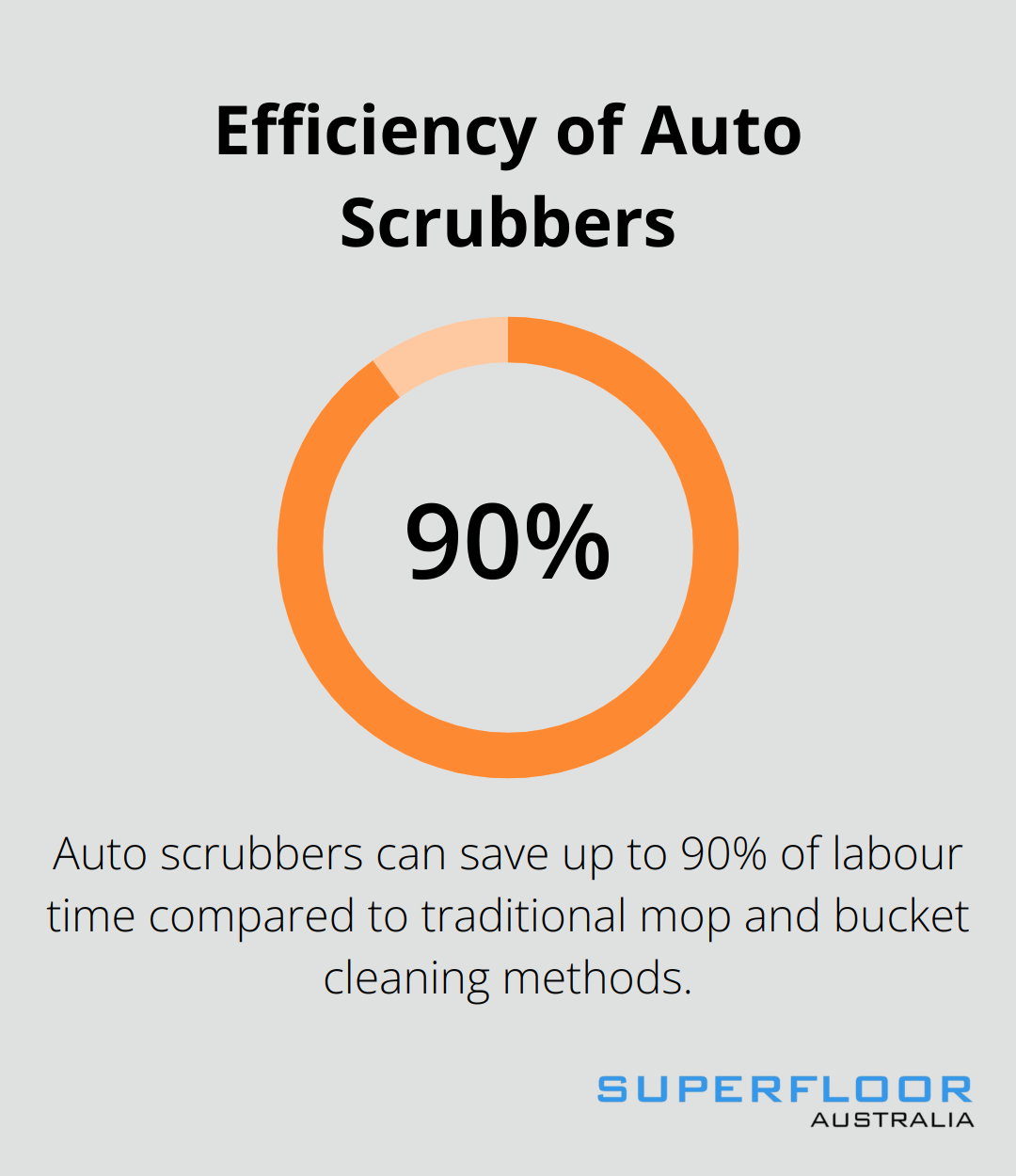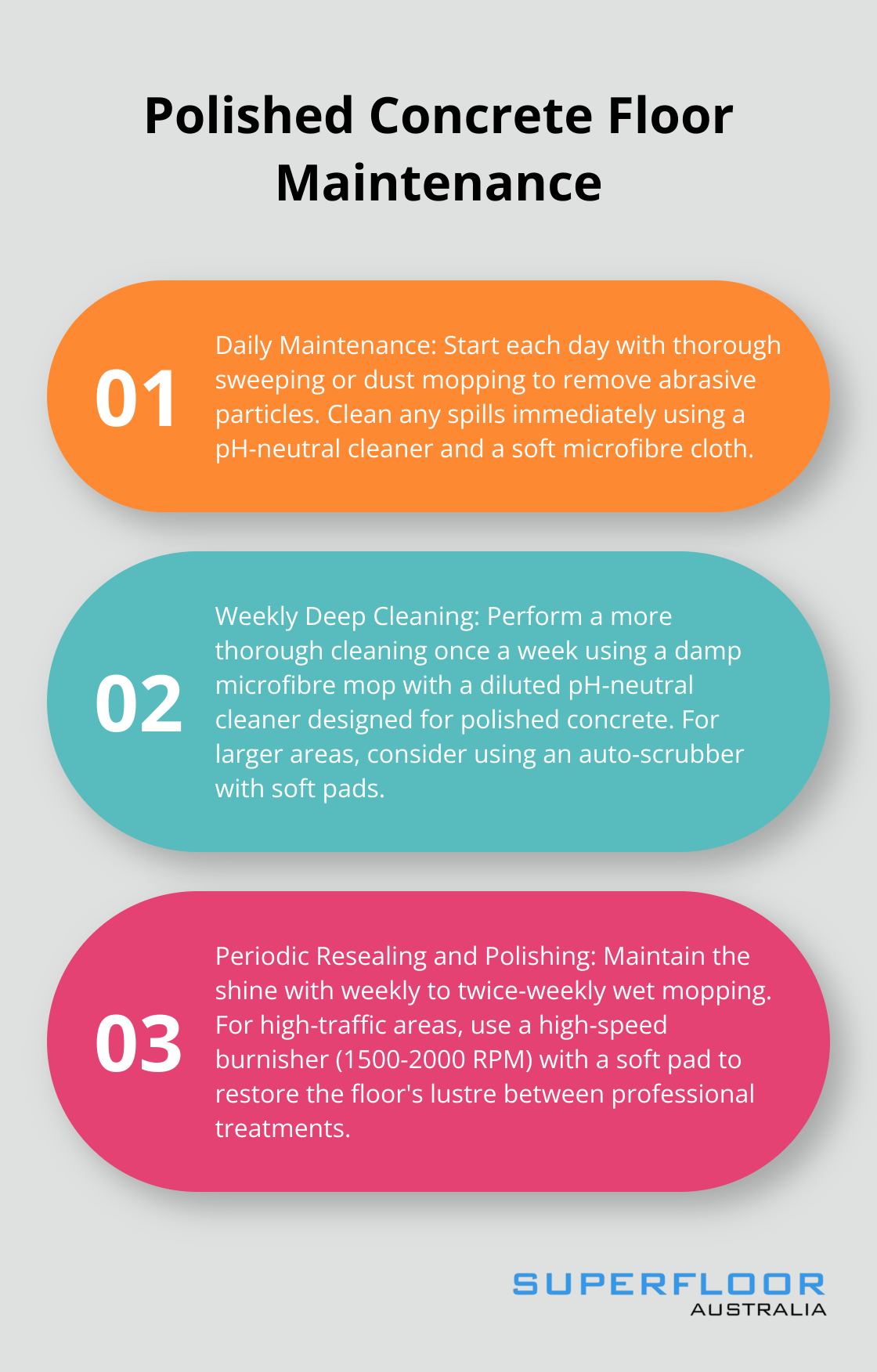At Superfloor Australia, we understand the importance of maintaining polished concrete floors to preserve their beauty and longevity.
Polished concrete floors are a popular choice for their durability and aesthetic appeal, but they require proper care to keep them looking their best.
In this guide, we’ll share our expertise on how to effectively clean and maintain your polished concrete floors, including the best cleaner for polished concrete floors and essential techniques for tackling common stains and dirt.
What Makes Polished Concrete Floors Unique?
The Science Behind the Shine
Polished concrete floors represent a pinnacle of modern flooring technology. These floors consist of a mixture of cement, water, and aggregates, but their uniqueness stems from a meticulous grinding and polishing process. This process uses progressively finer grinding tools to create a smooth, reflective surface.
The polishing process doesn’t just enhance aesthetics; it transforms the floor’s properties. As we grind and polish, we densify the concrete surface. This process increases the floor’s hardness, durability, and resistance to abrasion. Through capillary action, the densifier is drawn into the surface of the concrete to interact with the calcium hydroxide, a by-product of cement hydration.
Benefits of Choosing Polished Concrete
Polished concrete floors offer more than just visual appeal. They provide a range of practical advantages that make them an excellent choice for various settings:
- Exceptional Durability: A study by the National Ready Mixed Concrete Association found that concrete floors can last up to 100 years with proper maintenance.
- Stain Resistance: The densified surface repels most liquids, providing ample time to clean up spills before they set in. This feature makes them popular in high-traffic areas like retail stores and warehouses.
- Low Maintenance: Unlike other flooring options that require regular waxing or sealing, polished concrete only needs routine cleaning to maintain its shine. This characteristic leads to significant cost savings over time.

Common Challenges and Solutions
Despite their robustness, polished concrete floors face certain challenges:
- Oil and Grease: These substances can penetrate the concrete and create stubborn stains if left unattended.
- Acidic Substances: Materials like vinegar or citrus juices can etch the surface, dulling its shine and potentially causing permanent damage. We recommend prompt cleanup of spills and the use of pH-neutral cleaners for routine maintenance.
- Abrasive Materials: Sand or grit can scratch the surface over time if not regularly removed. Daily sweeping or dust mopping (especially in high-traffic areas) helps prevent this issue.
Understanding these characteristics and potential challenges forms the foundation for effective polished concrete floor maintenance. With proper care, these floors can retain their beauty and functionality for decades.
As we move forward, let’s explore the essential tools and products needed to keep your polished concrete floors in top condition.
Essential Tools for Polished Concrete Maintenance
The Magic of Microfibre
Microfibre mops and cloths stand out as indispensable tools for daily maintenance of polished concrete floors. These tools excel at trapping dust and dirt particles without scratching the polished surface. Several studies have determined that microfibre is better than cotton at capturing bacteria, highlighting their effectiveness and hygiene benefits.
We suggest using a dry microfibre mop for daily dust removal and a damp one for weekly cleaning. For stubborn stains, apply a microfibre cloth with a pH-neutral cleaner to spot clean without risking damage to the floor’s finish.
Selecting the Ideal Cleaner
pH-neutral cleaners play a critical role in maintaining polished concrete integrity. Acidic or alkaline cleaners can potentially etch or dull the surface over time. Opt for cleaners specifically formulated for polished concrete, as these will preserve the floor’s shine without leaving residue.
For routine cleaning, dilute the cleaner as per the manufacturer’s instructions. Using excessive cleaner can result in buildup, which may dull the floor’s appearance over time.
Conquering Tough Stains
While polished concrete resists most stains, accidents occur. For oil-based stains, a poultice made from a mixture of acetone and an absorbent material (like diatomaceous earth) proves effective. Apply the poultice, cover with plastic, and remove after 24 hours.
For organic stains (such as coffee or wine), a mixture of hydrogen peroxide and a few drops of ammonia can work wonders. Always test any stain removal solution on a small, inconspicuous area first.
Professional-Grade Equipment
For larger areas or commercial spaces, a burnisher or auto-scrubber can significantly reduce cleaning time and effort. According to ISSA, the use of auto scrubbers can save up to 90% of labour time compared to traditional mop and bucket cleaning methods.
When choosing a burnisher, select one with at least 1,500 RPM for optimal results. For auto-scrubbers, use soft, non-abrasive pads to protect the floor’s surface from scratches.

With these tools at your disposal, you’re well-equipped to tackle the cleaning process. Let’s now explore the step-by-step procedure for effectively cleaning your polished concrete floors.
How to Clean Polished Concrete Floors
Daily Maintenance Routine
Start each day with a thorough sweep or dust mop. This simple step removes abrasive particles that can scratch the surface over time. For high-traffic areas, use a microfibre dust mop twice daily.
After sweeping, clean any spills immediately. Use a pH-neutral cleaner and a soft microfibre cloth. Don’t let spills sit, as they can etch or stain the surface if left unattended.
Weekly Deep Cleaning Procedure
Perform a more thorough cleaning once a week. Start by sweeping or dust mopping as usual. Then, use a damp microfibre mop with a diluted pH-neutral cleaner specifically designed for polished concrete. Don’t over-wet the floor; a slightly damp mop is sufficient.
Work in small sections, rinse the mop frequently to prevent spreading dirt. After mopping, use a clean, dry microfibre cloth to remove any remaining moisture. This step prevents water spots and streaks from forming.
For larger areas, an auto-scrubber with soft pads can be highly effective. For expansive spaces, a ride-on scrubber provides greater efficiency and ease, covering more ground quickly with less operator fatigue.

Addressing Specific Stains and Spills
Despite regular maintenance, tough stains can occur. For oil-based stains, apply a poultice made from baking soda and acetone. Cover the area with plastic wrap and let it sit for 24 hours before removing.
For organic stains (like coffee or wine), a mixture of hydrogen peroxide and a few drops of ammonia can be effective. Always test any cleaning solution on a small, inconspicuous area first.
Don’t use acidic cleaners or abrasive scrubbers, as these can damage the polished surface. If a stain proves particularly stubborn, consult with a professional for specialised treatment.
Periodic Resealing and Polishing
Weekly to twice-weekly wet mopping can also help retain your polished concrete floor’s appearance. For best results, use the products and methods recommended by professionals.
For high-traffic commercial areas, more frequent maintenance may be necessary.
Between professional treatments, maintain the shine with a high-speed burnisher. Use a 1500-2000 RPM burnisher with a soft pad to restore the floor’s lustre without damaging the surface.
Final Thoughts
Polished concrete floors require straightforward maintenance for long-term benefits. Regular sweeping, dust mopping, and prompt spill cleanup form an effective daily care routine. Weekly deep cleaning with a pH-neutral cleaner for polished concrete floors enhances this routine, ensuring your floors retain their lustre and durability.
Proper care of polished concrete floors offers advantages beyond aesthetics. These floors become more resistant to stains and wear, reducing the need for costly repairs or refinishing. The smooth, sealed surface also improves indoor air quality by minimising dust and allergens, creating a healthier environment for occupants.
We at Superfloor Australia understand the importance of maintaining your polished concrete floors. Our expertise in delivering high-quality polished concrete flooring in Brisbane extends to providing guidance on proper care and maintenance. You can ensure your polished concrete floors remain a stunning and functional feature of your space for years to come.
